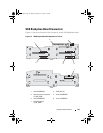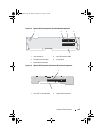
Glossary 169
Glossary
This section defines or identifies technical terms, abbreviations, and
acronyms used in your system documents.
A — Ampere(s).
AC — Alternating current.
ACPI — Advanced Configuration and Power Interface. A standard interface for
enabling the operating system to direct configuration and power management.
ambient temperature — The temperature of the area or room where the system is
located.
ANSI — American National Standards Institute. The primary organization for
developing technology standards in the U.S.
application — Software designed to help you perform a specific task or series of tasks.
Applications run from the operating system.
ASCII — American Standard Code for Information Interchange.
asset tag — An individual code assigned to a system, usually by an administrator, for
security or tracking purposes.
backup — A copy of a program or data file. As a precaution, back up your system’s
hard drive on a regular basis. Before making a change to the configuration of your
system, back up important start-up files from your operating system.
backup battery — A battery that maintains system configuration, date, and time
information in a special section of memory when the system is turned off.
beep code — A diagnostic message in the form of a pattern of beeps from your
system’s speaker. For example, one beep, followed by a second beep, and then a burst
of three beeps is beep code 1-1-3.
BIOS — Basic input/output system. Your system’s BIOS contains programs stored on
a flash memory chip. The BIOS controls the following:
• Communications between the processor and peripheral devices
• Miscellaneous functions, such as system messages
bit — The smallest unit of information interpreted by your system.
blade — A module that contains a processor, memory, and a hard drive. The modules
are mounted into a chassis that includes power supplies and fans.
BMC — Baseboard management controller.
Book.book Page 169 Monday, September 14, 2009 12:57 PM


















